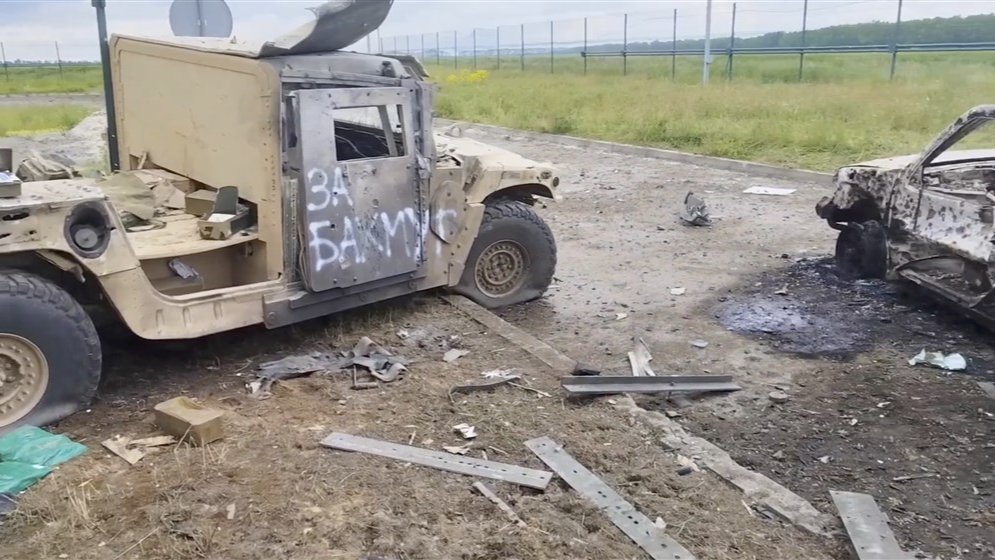A Russian national who took part in the raid on Russia’s Belgorod region from the side of Ukraine on 22 May has contacted Novaya-Europe to share his account of what happened. He spoke on the condition of anonymity and asked us not to name the unit that he serves in. Here’s his story.
Novaya-Europe does not condone war or similar warfare tactics. We also categorically oppose the use of violence against civilians by any of the warring parties.
4x4s stuck in the trenches
On the eve of the raid, the weather turned bad, and the ground got very muddy. The road leading to the checkpoint between Russia and Ukraine was all dug up, so we had to move right across the field. The paths to the border were all swamped. Many cars got stuck in the mud, and some of them couldn’t even take part in the planned operation. Because of this, the operation started half-a-day late, so we couldn’t achieve all that we set out to do.
In the end, about ten cars and armoured vehicles managed to reach the border. There were about 150 of us in total.
There was no artillery shelling from Uragan rocket launchers from the Ukrainian side. We ourselves used 120-mm mortars to open fire at the Grayvoron border checkpoint.
The checkpoint was well-fortified. There were concrete structures, permanent firing points connected through the trenches, as well as four or five armoured personnel carriers with 30-mm cannons and large-calibre machine guns. The checkpoint was guarded by border officers and motorised infantry. When we launched the attack under the cover of a tank, all the defenders scattered. They left their documents there. One of those running away didn’t make sense of the situation quickly enough, got in the way, and was killed. The other border guard who holed up in the basement was taken prisoner in the evening.
We managed to start two armoured personnel carriers and took at least one of them back as a trophy. Not sure what happened to the other one.
The video that shows two American Humvees (HMMWV) was shot at the location where our four-by-fours got stuck in the trenches near the border checkpoint. The flimsy wooden bridges couldn’t hold their weight.
Dead streets
After we seized the checkpoint, we all focused on our objectives. The first group went to warn civilians not to leave their houses. They reached the district centre very fast. When the second group came in (I was part of that group), there was no one around in the villages. Dead streets.
A few hours after the operation had begun, the Russians snapped out of it and started to send in their units, artillery, and aviation. They started firing at us, all kinds of weapons were used. They launched cluster munitions from Grads. We saw Su-25 fighters and military helicopters. By the evening, they’d gotten the hang of it. Some of our guys got light injuries.
What’s worth noting is that
in Grayvoron, the Russians launched artillery attacks not just on the outskirts where the Russian Volunteer Corps and the Freedom of Russia Legion were located; they also targeted the buildings that they thought we’d seized: the FSB office, the police station, and the administration.
Eyewitnesses report that this led to many injuries among civilians.
No one tried to stop us in the villages. We were only met with serious resistance at the district centre. I reached the outskirts of the small town and went on to complete my objectives. By the evening, me and my fellow fighters had come back to the border. We left in a calm and organised manner with the armoured carrier the next day.
I heard on the radio that some of our guys had managed to take down a helicopter near Grayvoron. I didn’t see it myself, but I’m sure that it did happen.
Belgorod is next
Our initial objective was to seize the district centre. Had all our forces entered Russia on time and had we moved according to the schedule, seized Grayvoron, and made fortifications there, we could have held the town for a full week, no problem. Take a look at the map: the landscape there is very good for defence. Rivers and swamps are everywhere.
It seems that another goal was the Belgorod-22 military town. There were rumours that tactical nukes were kept there. If we wanted, I think that we could have captured it. But we didn’t receive any orders to do so.
I know for sure that there are significant losses on the Russian side: killed and injured soldiers. I’m not going to disclose our losses.
We’re only learning. And we’re getting stronger. We will improve. We’ll organise new raids. Sabotage groups will be followed by combined arms operations. This time, we tried to seize a district centre, but next time, we might try to reach the regional capital. More people will want to join our ranks after this. They’re lining up. We’re getting more requests. Because we’re not just a marginalised group, we’re a well-trained, well-prepared, and armed formation. People want to join us.
Putin is getting a taste of his own medicine. Russia used to say “they’re not there” (about their forces being present in Donbas since 2014 — translator’s note), and now, the boomerang returns: “we’re not here” either! You reap what you sow.
Join us in rebuilding Novaya Gazeta Europe
The Russian government has banned independent media. We were forced to leave our country in order to keep doing our job, telling our readers about what is going on Russia, Ukraine and Europe.
We will continue fighting against warfare and dictatorship. We believe that freedom of speech is the most efficient antidote against tyranny. Support us financially to help us fight for peace and freedom.
By clicking the Support button, you agree to the processing of your personal data.
To cancel a regular donation, please write to [email protected]

